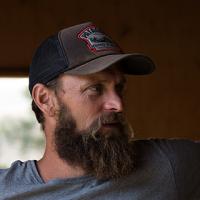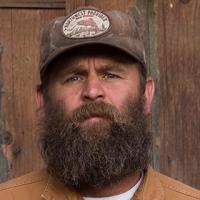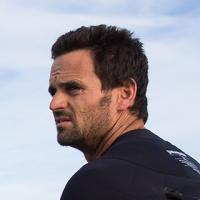The Malloy Brothers
Photography and story by Jeff Johnson
But it has been a slow road. Although Dan is arguably one of the best “free” surfers in the world, his rankings on the pro tour show otherwise.
For his brothers, there aren’t many expectations to fill. They know how difficult it is to do well at Sunset Beach, an arena notorious for big, funky, irregular surf. But today, the water is an opaque turquoise blue, and the waves are big — the size of telephone poles. Dan is trying to match his freakish, natural ability with the nuances of contest surfing. He’s more discerning than ever with his wave selection. Just before the end of his heat, he catches a set wave. He makes the long drop, fading confidently back toward the towering white water, turns at the bottom, and pulls up into a giant tube ride. Dan disappears, a couple seconds of ride that seem to last a lifetime, and emerges out on the face. The crowd of spectators erupts. He can hear the hoots and crackling applause as he paddles toward the beach.
After the awards ceremony, Dan straps his surfboard on top of his ’65 Chevelle and drives home. On the way, a strange, unsatisfied feeling comes over him. This unexpected sentiment has him thinking — why did I even start surfing? He is more passionate about surf exploration, seeing the world, and discovering new possibilities. This contest is the final nail in the coffin. Dan decides to walk away from competitive surfing…forever.
Chris, the oldest Malloy brother, arrives at the house and finds Dan at the kitchen table eating a bowl of cereal.
“How was the contest?” asks Chris.
Dan, with a mouthful of corn flakes and milk dripping from his chin says, “There were a couple good ones.”
Later that day, as the news moves through the coconut wireless, the word is out.
Dan Malloy had actually won the contest.
I’ve known the three brothers for over 20 years now. We shared a beach house on the North Shore when we first met. It was a prime location, smack dab at the epicenter of the surf world. From our deck, looking left, we could peer into the cavernous tubes of the famous Banzai Pipeline. Out front we had the playful waves of Rocky Point, and down the beach to the right, was the revered Sunset Beach. We had a climbing (training) wall in the garage, 100+ surfboards lying around, canoes, paddleboards and an assortment of ocean watercraft in racks outside and under the house. There was never a dull moment. Dan’s blasé reaction to Chris’ inquiry about the contest was par for the course, a casual interface that continues to this day. If I could say one thing about the Malloy brothers, it would be that they are unwaveringly understated.
It’s midnight at the North Shore house, November 1996. Some yelling in the front yard wakes me up. It has been raining all night and the power is out. I make my way through the house to the living room and stand there in the darkness. The yelling grows louder as I press my face against the window screen to see outside. Lightning strikes and I see Chris jump off our fence into the flooded front yard. I hear crazy laughter and a shuddering boom. In another flash, I see Chris backstroking across the yard as if he is doing laps in public pool. The rain is coming down harder, louder, and I can still hear him while I lay back in bed.
Around 5:00 a.m.,, I hear rapping on a window. It’s our friend Todd Chesser with a shit-eating grin on his face trying to wake Chris up. Then I hear the sound of wax on surfboards. Back out in the living room, again, I see Chris and Todd paddling their “big boards” out the driveway and down the street.
As a lifeguard, I am called to work at Waimea Bay. “The Bay,” as it is called, is famous for hosting some of the largest rideable waves on Earth. This day is the biggest (50-foot faces) and roughest I had ever seen. The river had flooded out from the valley pushing a torrent of water through the outer break. The color of the bay has turned from crystal-clear blue to a chocolate brown. Our job as lifeguards is to keep surfers from paddling out to what looks like certain death. But there’s already a small handful of guys out there. They had paddled out at the crack of dawn.
From the lifeguard tower, we see some of the gnarliest waves ever ridden at Waimea. One wave in particular, caught by a “goofy-foot” (surfing on his backhand), which is decidedly more difficult, is the most impressive. A big set rolls in and he paddles deeper than the rest of the crew and takes off on the steepest part of the wave. As he gets to his feet, we at the lifeguard tower watch anxiously and write him off as a goner. But somehow, he manages to stick an airdrop and make it, miraculously, into the channel. I look through my binoculars to see who it is but he’s too far out to tell.
A few minutes later, dark lines appear on the horizon. Cars parked around the Bay are honking their horns. This set looks bigger than the last. The small pack of surfers start paddling toward the channel and it looks like this one will catch them all. I look through my binoculars and there he is again, that goofy-foot, taking off deep in the pit of the wave. He free-falls from the lip, but this time he has no chance of making it. White water explodes all around him and he is gone. I’m searching the whitewash that has filled the bay. Nothing. Eventually I see him pop up way inside, crawling onto his board and paddling back out.
By noon, this early crew of surfers is making their way into the beach. With a closer look, I see that the goofy-foot we’d been watching all morning is Chris. That night back at the house, while eating Hawaiian poke and drinking cheap beer, I hear Chris on our doorstep talking with someone.
“You get in the water today?” the guy asks Chris.
“Yeah.”
“Really? Waimea? How was it?”
“It was fun,” Chris mumbles with swig of beer, “There were a couple.”
It’s October 2007. I invite Keith, the middle brother, to climb the North American Wall on El Capitan in Yosemite Valley. Although I had taken Keith on a couple of easy climbs, he is by no means a climber. In fact, he’s admittedly afraid of heights and doesn’t really respond to my invite. For this one, I assure him, we will be in good hands.Two seasoned, Big Wall experts will be joining us. With a slight nod, he says he’d do it. Then he looks me square in the face and asks me if it’s safe. He’s not going to like the answer so I change the subject.
El Capitan is the largest single piece of granite in the world. At 3,000 feet high it can take multiple days to scale its steep, overhanging face. The day before the climb, Keith and I are in the El Capitan meadow looking up at the towering monolith where climbers, if you can see them, are the size of ants. Keith is talking on his phone and I hear him say, “We’re going to climb Half Dome tomorrow.” The poor guy is so in the dark he doesn’t even know which big wall we will be climbing.
On the fifth day of the climb, we arrive at the Cyclops Eye, a large indentation in the rock, three-quarters of the way up the wall. The next morning, we are halted by a snowstorm. We spend the next 24 hours in the Cyclops, confined to our cramped portal-edge tents, which hang from the wall. Keith has hardly talked the whole climb. Now he just lays quietly in his sleeping bag. I think about what he must be going through. This is my third time up El Capitan and I’m hardly used to it. It’s such a bizarre world up here, not to mention the mental and physical strain over multiple days. I start to feel bad, like I’ve gotten him in way over his head.
We awake the next morning to bluebird conditions. It is cold, crisp, and unbelievably clear. The storm has set us back two days and we’ve begun to ration food and water. Keith is showing signs of excitement as we lower him out on a rope, over the abyss, 2,500 feet of air below and nothing but sky above. He yelps – a muffled attempt to yodeling, that come out as a warble with his heart in his throat.
We finally top out after seven days on the wall. Keith is a little more talkative now that he’s on level ground. But he’s having trouble on the descent to the valley floor. He says his knee has been hurting for a few days, though he didn’t mention this to anyone during the climb. It turns out Keith had been suffering a badly torn meniscus.
One month later, while traveling, I get an email from Chris. There’s a picture of Keith riding an absurdly massive wave at Maverick’s in Northern California. Chris writes: “Keith, on the biggest wave of his life one week before knee surgery.”
The next time I see Keith, I ask him about that wave, “the biggest wave of his life”.
He says, “Yeah, it was pretty fun out there.”
“How about your knee?”
Keith bends his leg a few times, looking at it.
“It’s pretty good,” he says.



